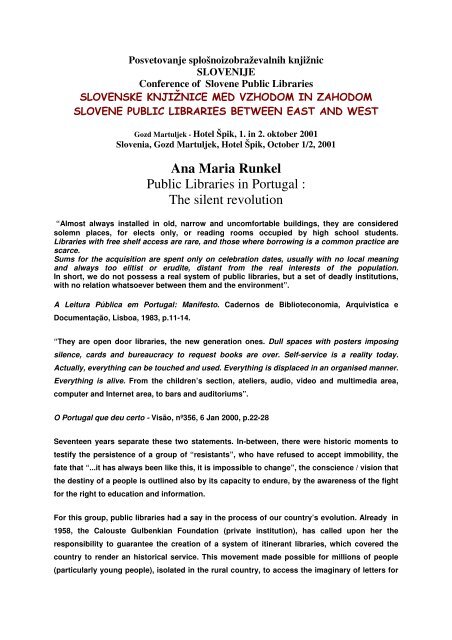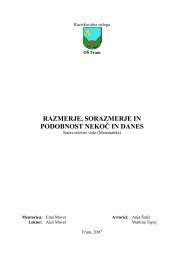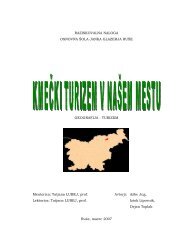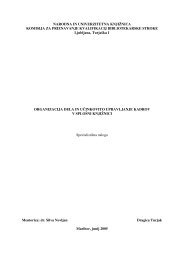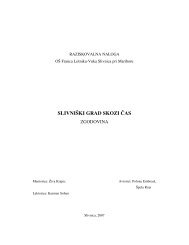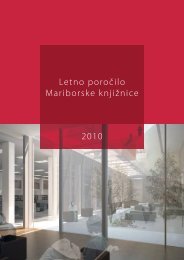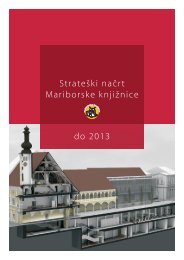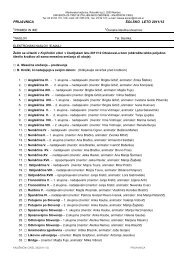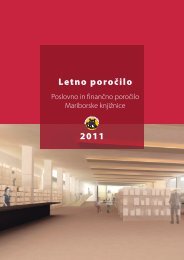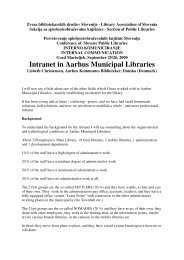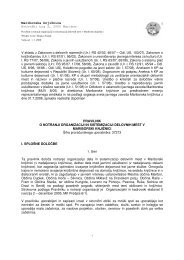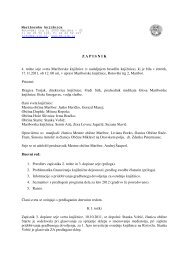Ana Maria Runkel Public Libraries in Portugal : The silent revolution
Ana Maria Runkel Public Libraries in Portugal : The silent revolution
Ana Maria Runkel Public Libraries in Portugal : The silent revolution
You also want an ePaper? Increase the reach of your titles
YUMPU automatically turns print PDFs into web optimized ePapers that Google loves.
Posvetovanje splošnoizobraževalnih knjižnic<br />
SLOVENIJE<br />
Conference of Slovene <strong>Public</strong> <strong>Libraries</strong><br />
SLOVENSKE KNJIŽNICE MED VZHODOM IN ZAHODOM<br />
SLOVENE PUBLIC LIBRARIES BETWEEN EAST AND WEST<br />
Gozd Martuljek - Hotel Špik, 1. <strong>in</strong> 2. oktober 2001<br />
Slovenia, Gozd Martuljek, Hotel Špik, October 1/2, 2001<br />
<strong>Ana</strong> <strong>Maria</strong> <strong>Runkel</strong><br />
<strong>Public</strong> <strong>Libraries</strong> <strong>in</strong> <strong>Portugal</strong> :<br />
<strong>The</strong> <strong>silent</strong> <strong>revolution</strong><br />
“Almost always <strong>in</strong>stalled <strong>in</strong> old, narrow and uncomfortable build<strong>in</strong>gs, they are considered<br />
solemn places, for elects only, or read<strong>in</strong>g rooms occupied by high school students.<br />
<strong>Libraries</strong> with free shelf access are rare, and those where borrow<strong>in</strong>g is a common practice are<br />
scarce.<br />
Sums for the acquisition are spent only on celebration dates, usually with no local mean<strong>in</strong>g<br />
and always too elitist or erudite, distant from the real <strong>in</strong>terests of the population.<br />
In short, we do not possess a real system of public libraries, but a set of deadly <strong>in</strong>stitutions,<br />
with no relation whatsoever between them and the environment”.<br />
A Leitura Pública em <strong>Portugal</strong>: Manifesto. Cadernos de Biblioteconomia, Arquivistica e<br />
Documentação, Lisboa, 1983, p.11-14.<br />
“<strong>The</strong>y are open door libraries, the new generation ones. Dull spaces with posters impos<strong>in</strong>g<br />
silence, cards and bureaucracy to request books are over. Self-service is a reality today.<br />
Actually, everyth<strong>in</strong>g can be touched and used. Everyth<strong>in</strong>g is displaced <strong>in</strong> an organised manner.<br />
Everyth<strong>in</strong>g is alive. From the children’s section, ateliers, audio, video and multimedia area,<br />
computer and Internet area, to bars and auditoriums”.<br />
O <strong>Portugal</strong> que deu certo - Visão, nº356, 6 Jan 2000, p.22-28<br />
Seventeen years separate these two statements. In-between, there were historic moments to<br />
testify the persistence of a group of “resistants”, who have refused to accept immobility, the<br />
fate that “...it has always been like this, it is impossible to change”, the conscience / vision that<br />
the dest<strong>in</strong>y of a people is outl<strong>in</strong>ed also by its capacity to endure, by the awareness of the fight<br />
for the right to education and <strong>in</strong>formation.<br />
For this group, public libraries had a say <strong>in</strong> the process of our country’s evolution. Already <strong>in</strong><br />
1958, the Calouste Gulbenkian Foundation (private <strong>in</strong>stitution), has called upon her the<br />
responsibility to guarantee the creation of a system of it<strong>in</strong>erant libraries, which covered the<br />
country to render an historical service. This movement made possible for millions of people<br />
(particularly young people), isolated <strong>in</strong> the rural country, to access the imag<strong>in</strong>ary of letters for
the first time, to discover another world full of differences and to fulfil their wish for more<br />
knowledge.<br />
However, it was not enough. An action from the government was <strong>in</strong>dispensable as a testimony<br />
of a nation who voted for democracy. In 1986, by the Secretaria de Estado da Cultura, a <strong>Public</strong><br />
Library Work<strong>in</strong>g Group was f<strong>in</strong>ally created, to prepare a report on the “state of the arts”<br />
(Decree Nr. 23/86) This extremely important report for the development of <strong>Public</strong> <strong>Libraries</strong> <strong>in</strong><br />
<strong>Portugal</strong> aimed at def<strong>in</strong><strong>in</strong>g the support of a national policy for public read<strong>in</strong>g, which would<br />
“essentially be based on the regular and efficient establishment and operation of a net of<br />
Municipal <strong>Libraries</strong>, and on structural development” which, at central and local level, could<br />
more directly support them.<br />
This work, which suggested immediate <strong>in</strong>tervention measures, besides conceptual and<br />
programmatic guidel<strong>in</strong>es on libraries to be created, lead to the preparation of a public read<strong>in</strong>g<br />
plan, <strong>in</strong> 1987, through the Instituto Português do Livro e da Leitura (Portuguese Institute for<br />
Read<strong>in</strong>g and Books). <strong>The</strong> creation of a net of <strong>Public</strong> Read<strong>in</strong>g <strong>Libraries</strong> was thus proposed,<br />
based upon the municipality which <strong>in</strong>cludes a Municipal Library, located at its headquarters, <strong>in</strong><br />
the central area or another highly populated area, and Branches <strong>in</strong> different areas, accord<strong>in</strong>g to<br />
the number and distribution of the population.<br />
Tenders (8 to date), which determ<strong>in</strong>e an application process to the National Net of <strong>Public</strong><br />
<strong>Libraries</strong>, from the municipalities want<strong>in</strong>g to establish a local net of public read<strong>in</strong>g libraries, are<br />
periodically submitted.<br />
Together with the Instituto Português do Livro e das Bibliotecas (entity with authority over this<br />
program), and other bodies of the Central Adm<strong>in</strong>istration (for example, Regional Coord<strong>in</strong>ation<br />
Committees), the municipalities selected are expected to plan the creation and development of<br />
all libraries projected based upon a program contract.<br />
Under the contract signed between Central and Local Adm<strong>in</strong>istration, several rigorous<br />
demands must be met before the payment of 50% of the project costs for architecture,<br />
build<strong>in</strong>g/build<strong>in</strong>gs adaptation, equipment acquisition, document funds, service<br />
computerisation and tra<strong>in</strong><strong>in</strong>g workshops is granted.<br />
<strong>The</strong> municipalities apply to one of the programs def<strong>in</strong>ed by a library typology, determ<strong>in</strong>ed by<br />
the size of the population. This typology compels that specific characteristics are met<br />
regard<strong>in</strong>g size areas to be respected, equipment and services, collection (books and nonbooks<br />
material), and m<strong>in</strong>imum staff required at the Library (see the developed typology<br />
enclosed).
This policy of stimulat<strong>in</strong>g the establishment of municipality nets of <strong>Public</strong> <strong>Libraries</strong>, which<br />
started <strong>in</strong> 1987, show remarkable results:
From the 278 Municipalities <strong>in</strong> <strong>Portugal</strong> (not <strong>in</strong>clud<strong>in</strong>g the islands of Madeira and Azores), 209<br />
(75 %) have or are prepar<strong>in</strong>g to have a Library.<br />
Implementation of the net:<br />
Evolution<br />
In 2000, the Portuguese government made a commitment that all municipalities should have a<br />
<strong>Public</strong> Library before 2003. <strong>The</strong> estimate for the total f<strong>in</strong>anc<strong>in</strong>g of this program is 1 million<br />
Euros from the M<strong>in</strong>istério da Cultura, amount<strong>in</strong>g to 50% of the total <strong>in</strong>vestment.<br />
This <strong>revolution</strong>, which started about thirteen years ago, is leav<strong>in</strong>g visible marks <strong>in</strong> the urban<br />
tissue (due to the aesthetically pleasant build<strong>in</strong>gs designed) and <strong>in</strong> the social tissue (due to the<br />
discovery and consumption which can be witnessed <strong>in</strong> large fr<strong>in</strong>ges of the population).<br />
Some <strong>in</strong>dicators confirm this statement and show an extraord<strong>in</strong>ary evolution.<br />
Some <strong>in</strong>dicators confirm this statement and show an extraord<strong>in</strong>ary evolution.
(1) In: Millem<strong>in</strong>um Study
In a study on a Library outside the capital (Oeiras – new library opened <strong>in</strong> 1996) it was possible<br />
to witness a surpris<strong>in</strong>g evolution at the level of users who look for Library services.<br />
At the level of <strong>in</strong>stitutional importance of library services, there has been an <strong>in</strong>crease, which<br />
lifted the library from non-existence on functional organisation charts, to its establishment as a<br />
Division on the same level as other more traditional municipality sectors, such as sanitation,<br />
hous<strong>in</strong>g or plann<strong>in</strong>g. This situation allows to obta<strong>in</strong> a budget for the service, as well as the<br />
possibility of <strong>in</strong>terven<strong>in</strong>g/<strong>in</strong>fluenc<strong>in</strong>g strategic options. In short, the library is slowly ga<strong>in</strong><strong>in</strong>g<br />
visibility, basic condition to be able to <strong>in</strong>fluence and emphasise the pr<strong>in</strong>ciples it is entrusted<br />
with.<br />
Likewise, this policy has had a multiply<strong>in</strong>g effect at <strong>in</strong>fluenc<strong>in</strong>g the creation of somewhat<br />
similar programs, such as a l<strong>in</strong>e of action for the restructur<strong>in</strong>g of Archives (1998) and a<br />
program for the establishment of a net of School <strong>Libraries</strong> (1997). <strong>The</strong> model adopted is<br />
similar, the Central government act<strong>in</strong>g as a catalyst <strong>in</strong> the process of renew<strong>in</strong>g these services.<br />
A program for the f<strong>in</strong>anc<strong>in</strong>g of the reconstruction/adaptation of space, equipment, furniture,<br />
documentation and comput<strong>in</strong>g system offers the local authority the possibility, to progress <strong>in</strong><br />
the (re)build<strong>in</strong>g of these knowledge <strong>in</strong>stitutions.
When try<strong>in</strong>g to briefly assess the situation of <strong>Public</strong> <strong>Libraries</strong> <strong>in</strong> <strong>Portugal</strong> <strong>in</strong> the year<br />
2001, we can say that:<br />
<strong>The</strong>ir strengths ...<br />
<br />
Strong commitment from the central government to create conditions for modernis<strong>in</strong>g<br />
public read<strong>in</strong>g.<br />
<br />
Progressive sensitisation of politicians for the importance of <strong>in</strong>vest<strong>in</strong>g <strong>in</strong> public read<strong>in</strong>g<br />
libraries.<br />
<br />
Creation of services directed to the community (Information services to citizens, promotion<br />
of books and read<strong>in</strong>g, tra<strong>in</strong><strong>in</strong>g <strong>in</strong> the area of Information and Communication Technologies<br />
(ICT), special services for babies, handicapped, socially excluded, elderly, m<strong>in</strong>orities)<br />
<br />
Innovative and multiply<strong>in</strong>g project at national level, with grow<strong>in</strong>g positive image <strong>in</strong> the<br />
media at national level, and the professional community at <strong>in</strong>ternational level.<br />
<strong>The</strong>ir weaknesses ...<br />
<br />
Too strong growth <strong>in</strong> launch<strong>in</strong>g the support program, fragility <strong>in</strong> the number of human<br />
resources available.<br />
<br />
Politicians <strong>in</strong>terest based essentially upon “build<strong>in</strong>g construction”.<br />
<br />
Scatter<strong>in</strong>g of the <strong>in</strong>vestment aggravated by the lack of adequate resources to the<br />
development of these programs.<br />
<strong>The</strong>ir opportunities ...<br />
<br />
Create a large group of professionals and develop tra<strong>in</strong><strong>in</strong>g centres.<br />
<br />
Promote a campaign / lobby directed to politicians and the community <strong>in</strong> general, on the<br />
importance of public read<strong>in</strong>g and its determ<strong>in</strong><strong>in</strong>g role <strong>in</strong> the Information Society.<br />
<br />
Creation of a national or regional plan for the co-operation among libraries/municipalities,<br />
outl<strong>in</strong><strong>in</strong>g common strategies of action <strong>in</strong> the approach of problems which transversely<br />
affect the whole society.<br />
<strong>The</strong>ir threats ...<br />
<br />
To compromise the efficient exploitation of exist<strong>in</strong>g material resources.
Small <strong>in</strong>vestment <strong>in</strong> service ma<strong>in</strong>tenance, which can compromise its evolution.<br />
<br />
To supply non-efficient services and lose the historic opportunity of act<strong>in</strong>g and mak<strong>in</strong>g a<br />
difference among the population.<br />
<strong>The</strong> current turn<strong>in</strong>g po<strong>in</strong>t makes us aware of the urgent need to be actors, creators and<br />
promoters of our scene on the stage. <strong>The</strong> evolution tends to ga<strong>in</strong> a dazzl<strong>in</strong>g speed, mak<strong>in</strong>g us<br />
run the risk of not tak<strong>in</strong>g time to reflect and of act<strong>in</strong>g automatically and without critical sense.<br />
However, good sense and the love for what we have been achiev<strong>in</strong>g makes us say that we will<br />
progressively f<strong>in</strong>d our way.<br />
In a country where illiteracy reached 33% <strong>in</strong> 1960 and 8% <strong>in</strong> 1999, where education costs <strong>in</strong> the<br />
same period raised from 1,5% to 6% and the number of high school students raised from 8.000<br />
to 400.000, libraries are surely part of the <strong>silent</strong> <strong>revolution</strong>, which is slowly be<strong>in</strong>g built and<br />
grow<strong>in</strong>g stronger to give the country the dest<strong>in</strong>y it desires.<br />
Some examples of how dreams came true<br />
<strong>The</strong> creation or adaptation of a library dest<strong>in</strong>ed for public read<strong>in</strong>g <strong>in</strong>volves a jo<strong>in</strong>t effort<br />
between political power, the determ<strong>in</strong>ant of <strong>in</strong>vestment, and staff (architects, eng<strong>in</strong>eers and<br />
librarians) who contribute with their imag<strong>in</strong>ation and specific knowledge.<br />
From these synergies result both good and average projects although there’s a constant<br />
struggle to guarantee the fulfilment of the public cause’s goals.<br />
<strong>The</strong> typology supplied by the IPLB determ<strong>in</strong>es, guides and controls the basic underly<strong>in</strong>g<br />
pr<strong>in</strong>ciples. Thus, it allows the implementation of a widely tested model (nowadays it results<br />
from work<strong>in</strong>g upon national experiences and service evolution whereas <strong>in</strong> previous years the<br />
French model played a crucial role). It is important to note that the success of a model goes<br />
beyond its application: there’s a constant need to adapt each model to its surround<strong>in</strong>g reality.<br />
In a prelim<strong>in</strong>ary phase the project requires the formation of a multidiscipl<strong>in</strong>ary team <strong>in</strong>clud<strong>in</strong>g<br />
elements from both the central and local adm<strong>in</strong>istration, librarians, architects and eng<strong>in</strong>eers<br />
who share a common language and a vision built upon a variety of motivations. <strong>The</strong> selection<br />
of the site, be it for construction or adaptation purposes, should take <strong>in</strong>to account both its<br />
ma<strong>in</strong>stream location and accessibility. Besides this, the site selection must allow for the<br />
application of guidel<strong>in</strong>es regard<strong>in</strong>g library dimensions and correct function<strong>in</strong>g, hav<strong>in</strong>g to<br />
respect base-l<strong>in</strong>e figures (see attached tables).<br />
One can say most libraries belong<strong>in</strong>g to the net of <strong>Public</strong> Read<strong>in</strong>g <strong>Libraries</strong> devise their<br />
entrance hall as a central organisational po<strong>in</strong>t from where a series of services are carried on:
• an area designed for adults offers loan<strong>in</strong>g services, <strong>in</strong>-place brows<strong>in</strong>g, access to<br />
reference books and periodical publications;<br />
• an area designed for youngsters offers similar services, yet specially devised for the<br />
different age groups <strong>in</strong> addition to animation activities;<br />
• f<strong>in</strong>ally, one may f<strong>in</strong>d a common area or an auditorium where multiple cultural activities<br />
may be carried out (e.g. exhibitions, colloquies, meet<strong>in</strong>gs with writers and other<br />
<strong>in</strong>dividualities).<br />
Some libraries also possess a cafeteria which, when well managed, may help attract users<br />
mak<strong>in</strong>g them want to return. Exist<strong>in</strong>g <strong>in</strong>ternal service areas are aimed at respond<strong>in</strong>g to<br />
emerg<strong>in</strong>g challenges <strong>in</strong> the management field, be<strong>in</strong>g it worthwhile to note the existence of a<br />
grow<strong>in</strong>g book deposit area.<br />
In what concerns the construction or recovery of the library build<strong>in</strong>g, there is usually the need<br />
to consider and respect the environmental characteristics as well as specific features related<br />
both to the relevant region and its related population. With respect to library facilities, a natural<br />
concern should go towards the follow<strong>in</strong>g aspects:<br />
• easy accessibility, tak<strong>in</strong>g <strong>in</strong>to account the need to elim<strong>in</strong>ate architectonic barriers<br />
which may difficult the access of the disabled;<br />
• acclimation conditions, <strong>in</strong> an attempt to create ecological build<strong>in</strong>gs, this way benefit<strong>in</strong>g<br />
from construction types;<br />
• light<strong>in</strong>g characteristics, to ensure both the quality of research conditions and the<br />
successful use of the different types of services;<br />
• the guarantee of develop<strong>in</strong>g an <strong>in</strong>formation technology and communications network<br />
which enables cont<strong>in</strong>ual growth, thus respond<strong>in</strong>g to <strong>in</strong>creas<strong>in</strong>g ICT demand.<br />
Another decisive step <strong>in</strong> the build<strong>in</strong>g of a library is the selection of its equipment and furniture.<br />
A jo<strong>in</strong>t effort between the librarian’s know-how and the architect’s aesthetic perspective has<br />
allowed for a merge between these languages which complete each other giv<strong>in</strong>g rise to<br />
attractive projects capable of generat<strong>in</strong>g satisfaction among community members.<br />
<strong>The</strong> selection of furniture constitutes one of the most important phases <strong>in</strong> this process.<br />
F<strong>in</strong>d<strong>in</strong>g a balance between the available budget and the design and utility of the several pieces<br />
of furniture has constituted a serious challenge already overcome by many libraries. This<br />
project has attempted to create attractive, ergonomic and welcom<strong>in</strong>g spaces where community<br />
members may f<strong>in</strong>d an <strong>in</strong>vit<strong>in</strong>g atmosphere.<br />
<strong>The</strong> solutions associated with the purchase of technological equipment like PC’s, pr<strong>in</strong>ters or<br />
scanners, be it for technical or reference work, Internet use or development of <strong>in</strong>dividual<br />
projects have progressively been altered. Thus, one <strong>in</strong>tends to meet the grow<strong>in</strong>g need and
<strong>in</strong>terest of apply<strong>in</strong>g ICT <strong>in</strong> society.<br />
Similarly, the <strong>in</strong>itial bet <strong>in</strong>volv<strong>in</strong>g the existence of video spots has given way to the<br />
development of self-learn<strong>in</strong>g areas based on ICT. An area which still stands is that <strong>in</strong>volv<strong>in</strong>g<br />
the audition of audio CD’s, although the option of these be<strong>in</strong>g loaned has reduced the grow<strong>in</strong>g<br />
trend.<br />
This whole process leads to a permanent need to be <strong>in</strong> touch with social and cultural trends as<br />
well as to deal with chang<strong>in</strong>g, dynamic <strong>in</strong>formation. Consequently, nowadays, the tendency is<br />
to withdraw physical barriers between library activities/areas.<br />
Once the sight is chosen, the construction guaranteed, the equipment and furniture bought,<br />
the next step is to put the library to work, to move on from the project to reality. A library has<br />
to be organized tak<strong>in</strong>g <strong>in</strong>to account the needs of both its external and <strong>in</strong>ternal users. <strong>The</strong><br />
magic words that guarantee a successful outcome are frequently difficult to f<strong>in</strong>d; one must be<br />
constantly alert and have the courage to put aside some of the <strong>in</strong>itial conjectures envisaged by<br />
the ideal library.<br />
A library is never concluded. As it’s be<strong>in</strong>g created it ga<strong>in</strong>s a life of its own; just like when<br />
Geppetto envisaged P<strong>in</strong>occhio, we, who contribute towards the construction of these entities<br />
have to be conscious of our limited <strong>in</strong>fluence as we transform simple matter <strong>in</strong>to an identifiable<br />
piece. While ga<strong>in</strong><strong>in</strong>g form, a library seems to breath from the atmosphere where it was born,<br />
from the mood of its workers , from the way <strong>in</strong> which it is handled. Observ<strong>in</strong>g closely each and<br />
every one of these entities, it is possible to identify the <strong>in</strong>fluences of several different jobs,<br />
nevertheless, each library will have to develop, adapt<strong>in</strong>g itself to its <strong>in</strong>habitants. Just like the<br />
body is a result of that it <strong>in</strong>gests, the library develops to be what its occupants make of it. It’s<br />
our obligation to guarantee such evolution as well as to make available our contribution <strong>in</strong> an<br />
attempt to satisfy a variety of participants.<br />
Ideal projects don’t exist, only feasible ones testify the <strong>in</strong>volvement of different <strong>in</strong>terveners, the<br />
capacity to communicate (more than 10 years gone s<strong>in</strong>ce the beg<strong>in</strong>n<strong>in</strong>g of this project have<br />
shown how dist<strong>in</strong>ct participants learn to respect and accept what each one has to say), as well<br />
as the assembl<strong>in</strong>g of deeply committed teams, both formed and <strong>in</strong>formed, about clients’<br />
<strong>in</strong>terests.<br />
Each library’s development challenges our capacity to evolve from dreams to reality. Formulae<br />
for ideal dreams aren’t available. Only h<strong>in</strong>ts may be given, yet each one of us will be expected<br />
to develop a specific course of action, know<strong>in</strong>g the work <strong>in</strong> progress is dest<strong>in</strong>ed for others.<br />
Our capacity to envisage the fulfilment of our f<strong>in</strong>al users’ expectations, be these real or<br />
potential, encloses the secret for success.<br />
Bibliography<br />
• Balanço positivo na leitura (1999)<br />
www.m<strong>in</strong>-cultura.pt/noticias/arquivo/noticiasagosto.html
• Carrilho regionaliza cultura (1998)<br />
www.expresso.pt/ed1327/c42.asp<br />
• A Leitura como estratégia (1998) Público, 16 Janeiro, p.26.<br />
• A leitura Pública em <strong>Portugal</strong>: Manifesto (1983) Cadernos de Biblioteconomia,<br />
Arquivistica e Documentação, Lisboa, p.11-14.<br />
• LIBCON2000<br />
www.libecon2000.org<br />
• <strong>Portugal</strong> que deu certo (2000) Visão, nº356, 6 Jan., p.22-28.<br />
• Rede Nacional prossegue até 2003 (2000)<br />
www.m<strong>in</strong>-cultura.pt/noticias/arquivo/noticiasfevereiro2000.html<br />
• Rede Nacional de Bibliotecas Públicas<br />
http://rbp.iplb.pt


